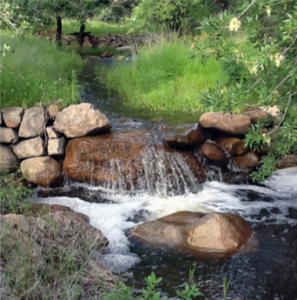Hydrologic Response of Streams Restored with Check Dams in the Chiricahua Mountains, Arizona
 In this study, hydrological processes are evaluated to determine impacts of stream restoration in the West Turkey Creek, Chiricahua Mountains, southeast Arizona, during a summer-monsoon season (June–October of 2013). A paired-watershed approach was used to analyze the effectiveness of check dams to mitigate high flows and impact long-term maintenance of hydrologic function. One watershed had been extensively altered by the installation of numerous small check dams over the past 30 years, and the other was untreated (control). We modifiedand installed a new stream-gauging mechanism developed for remote areas, to compare the water balance and calculate rainfall–runoff ratios.Results show that even 30 years after installation, most of the check dams were still functional. The watershed treated with check dams has a lower runoff response to precipitation compared with the untreated, most notably in measurements of peak flow. Concerns that downstreamflows would be reduced in the treated watershed, due to storage of water behind upstream check dams, were not realized; instead, flowvolumes were actually higher overall in the treated stream, even though peak flows were dampened. We surmise that check dams are a useful management tool for reducing flow velocities associated with erosion and degradation and posit they can increase baseflow in aridlands.© 2015 The Authors. River Research and Applications published by John Wiley & Sons, Ltd.
In this study, hydrological processes are evaluated to determine impacts of stream restoration in the West Turkey Creek, Chiricahua Mountains, southeast Arizona, during a summer-monsoon season (June–October of 2013). A paired-watershed approach was used to analyze the effectiveness of check dams to mitigate high flows and impact long-term maintenance of hydrologic function. One watershed had been extensively altered by the installation of numerous small check dams over the past 30 years, and the other was untreated (control). We modifiedand installed a new stream-gauging mechanism developed for remote areas, to compare the water balance and calculate rainfall–runoff ratios.Results show that even 30 years after installation, most of the check dams were still functional. The watershed treated with check dams has a lower runoff response to precipitation compared with the untreated, most notably in measurements of peak flow. Concerns that downstreamflows would be reduced in the treated watershed, due to storage of water behind upstream check dams, were not realized; instead, flowvolumes were actually higher overall in the treated stream, even though peak flows were dampened. We surmise that check dams are a useful management tool for reducing flow velocities associated with erosion and degradation and posit they can increase baseflow in aridlands.© 2015 The Authors. River Research and Applications published by John Wiley & Sons, Ltd.

